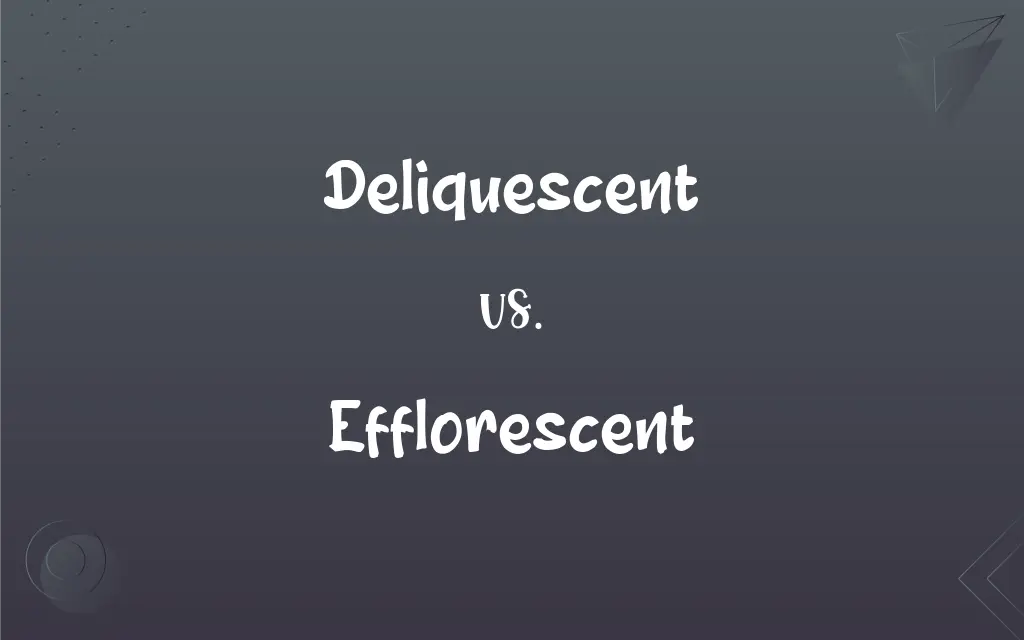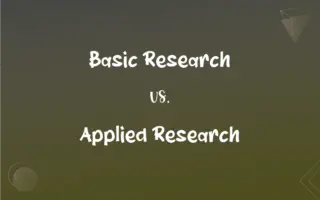Deliquescent vs. Efflorescent: What's the Difference?
Edited by Aimie Carlson || By Harlon Moss || Updated on October 24, 2023
Deliquescent substances absorb moisture from the air and dissolve, while efflorescent substances release water to the air, forming a powdery crust.

Key Differences
Deliquescent refers to a material or substance that has the ability to absorb moisture from the atmosphere until it dissolves in the absorbed water and forms a solution. On the opposite side of the spectrum, efflorescent describes substances that lose their water of crystallization upon exposure to air, often appearing as a powdery substance on the surface.
When observing a deliquescent substance, one would notice its tendency to become wet or even liquefy due to the attraction and retention of moisture. In contrast, an efflorescent substance will often display a white, powdery crust or crystalline residue, demonstrating the release of its water content.
In layman's terms, while deliquescent materials seem to "melt" or "dissolve" into a liquid in humid conditions, efflorescent materials seem to "dry out," leaving behind a residue.
Comparison Chart
Reaction with Humidity
Absorbs moisture and may dissolve in it.
Releases water, forming a powdery crust.
Appearance
Can become wet or liquefy.
Displays a powdery or crystalline residue.
ADVERTISEMENT
Water Interaction
Attracts and retains moisture.
Loses its water of crystallization.
Resultant Form
Often forms a solution.
Results in a dehydrated substance.
Use in Descriptions
Describes materials that "melt" in humidity.
Describes materials that "dry out" in air.
Deliquescent and Efflorescent Definitions
Deliquescent
A compound prone to becoming wet from atmospheric humidity.
The storage room was too humid, causing the deliquescent samples to degrade.
Efflorescent
The property of a material to shed its water content upon air exposure.
Bricks can sometimes have efflorescent characteristics, leading to white deposits.
ADVERTISEMENT
Deliquescent
A substance that absorbs moisture from the air until it dissolves.
Salt in humid conditions can be deliquescent.
Efflorescent
A substance that releases its water of crystallization when exposed to air.
The walls had white patches due to the efflorescent salts.
Deliquescent
The property of a substance to attract and retain atmospheric water.
Certain chemicals in the lab are deliquescent and need to be stored carefully.
Efflorescent
Crystals that lose water when subjected to a dry atmosphere.
The efflorescent mineral sample left a powdery substance on the shelf.
Deliquescent
Materials that can form a solution by attracting moisture.
Because of its deliquescent characteristics, the compound was stored in a sealed container.
Efflorescent
The phenomenon where a substance dries out, leaving a crystalline residue.
The efflorescent reaction was evident when the material was left in the open air.
Deliquescent
The act or process of becoming liquid or liquefied by absorbing moisture.
The deliquescent nature of some salts makes them unsuitable for certain applications.
Efflorescent
The act or process of losing water or other solvent as vapor.
The efflorescent nature of the compound was evident by the crusty residue left behind.
Deliquescent
To melt away.
Efflorescent
(Botany) A state or time of flowering.
FAQs
How can I identify an efflorescent substance?
An efflorescent substance often displays a white, powdery, or crystalline residue when exposed to air.
What does deliquescent mean?
Deliquescent refers to a substance's ability to absorb moisture from the air until it dissolves.
Can a substance be both deliquescent and efflorescent?
Typically, a substance is either deliquescent or efflorescent, not both, as they represent opposite reactions to humidity.
Why do deliquescent substances seem to "melt"?
They absorb atmospheric moisture and may dissolve in the retained water, giving a "melting" appearance.
How does efflorescent differ from deliquescent?
Efflorescent substances lose water to the air, forming a powdery crust, while deliquescent substances absorb moisture and may dissolve.
Do efflorescent substances lose their structural integrity?
Over time, repeated efflorescent reactions can weaken the substance.
Is the deliquescent property common in salts?
Yes, many salts, especially hygroscopic ones, display deliquescent properties in humid conditions.
What causes efflorescent reactions in bricks?
Salts present in bricks can release water upon exposure to air, leading to efflorescent deposits.
How does temperature impact deliquescent reactions?
Temperature can affect the rate of moisture absorption and the amount a substance can absorb.
Are deliquescent substances always hazardous?
Not always, but they can pose challenges in storage and use due to their moisture-absorbing nature.
Is efflorescence harmful to structures?
While it's primarily a cosmetic concern, efflorescence can indicate moisture issues in structures.
What industries commonly deal with efflorescent substances?
Construction, masonry, and ceramics often encounter efflorescent materials.
How can I store deliquescent materials?
Store them in airtight containers to prevent moisture absorption.
Do efflorescent reactions affect product quality?
Yes, efflorescence can alter the composition and appearance of products.
Can deliquescent substances harm electronic devices?
Yes, as they absorb moisture, they can cause corrosion or short circuits in electronics.
Do deliquescent reactions affect the weight of a substance?
Yes, as the substance absorbs moisture, its weight increases.
Can I prevent efflorescence on walls?
Using water-resistant materials, improving drainage, and using sealants can help prevent efflorescence.
Is efflorescence a sign of a bigger moisture problem?
Efflorescence indicates the presence of soluble salts and moisture, suggesting potential underlying moisture issues.
Can we reverse deliquescent reactions?
Reducing the humidity or moisture exposure can halt the process, but reversing it requires removing the absorbed water.
How is efflorescence treated in construction?
Efflorescence can be brushed off, washed away, or treated with specific chemicals to remove or prevent it.
About Author
Written by
Harlon MossHarlon is a seasoned quality moderator and accomplished content writer for Difference Wiki. An alumnus of the prestigious University of California, he earned his degree in Computer Science. Leveraging his academic background, Harlon brings a meticulous and informed perspective to his work, ensuring content accuracy and excellence.
Edited by
Aimie CarlsonAimie Carlson, holding a master's degree in English literature, is a fervent English language enthusiast. She lends her writing talents to Difference Wiki, a prominent website that specializes in comparisons, offering readers insightful analyses that both captivate and inform.































































